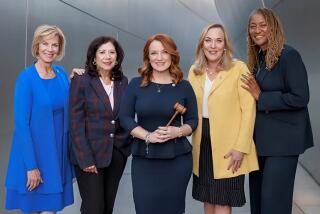Wrong Turn on Charter
A private summit aimed at building consensus for Los Angeles’ much-needed charter reform effort seems to have had the opposite effect. That’s no doubt because the person who called for the meeting last week pressed the same old unproductive drumbeat, insisting on elected neighborhood councils that would have decision-making authority on land-use questions.
On this issue, the drive for more accountable government and better citizen representation has been steered onto a dead-end road.
Erwin Chemerinsky, chairman of Los Angeles’ Elected Charter Reform Commission, hosted Wednesday’s private meeting at the USC School of Law. Before he left the gathering, he urged the 16 invitees to accept as a given that elected councils will be a part of the charter reform package that will be put before the voters next spring. Then he suggested that the group focus its attention on the exact role these neighborhood councils should have in making land-use decisions.
Darned odd, that, considering even Chemerinsky’s own commission has postponed indefinitely consideration of what kind of land-use authority these councils might have. The separate commission appointed by the City Council opposes the creation of elected councils. Elected neighborhood councils of any kind, much less those with direct city planning authority, are an invitation to a new layer of bureaucracy and not-in-my-back-yard-ism. Businesses rightly fear that homeowners could freeze out development, to the detriment of the city as a whole. And where’s the proof that most Angelenos, aside from those on several already powerful homeowner associations, are interested in elected neighborhood panels in the first place?
The real problem is a matter that The Times has addressed before: The average Los Angeles City Council member represents 250,000 constituents, or more residents than the entire populations of 87% of the nation’s 500 largest cities. Residents of the other nine largest cities in the nation are magnitudes better in terms of citizen representation, with an average of fewer than 108,000 residents per City Council member. Los Angeles should be so fortunate.
Clearly Los Angeles needs better representation, but that ought to be accomplished by a larger City Council that can be far more representative of the city’s diverse needs and interests and more responsive to the concerns of citizens. To be sure, major U.S. cities have strong networks of appointed neighborhood groups. But those groups have an advisory role only, even though their views may be given great weight by elected officials.
New York City’s 59 community boards, for example, are appointed by borough presidents. Half of their members are nominated by City Council members. The boards express positions on everything from the city’s budget to zoning matters and municipal services, but they cannot order any city agency or city official to perform tasks.
Phoenix has 13 “village planning committees” whose members are appointed by the City Council. They review general plan amendments, ordinances and rezoning requests and make recommendations on behalf of the regions they represent--all useful functions.
It’s wrong to suggest that elected neighborhood councils are necessary because appointees would be naturally beholden to the elected officials who chose them. It’s far more likely that they would quickly learn to go their own ways. The volunteer citizen groups in various parts of Los Angeles that already do a good job of pressing neighborhood concerns are an example of such independent leadership. Appointed groups can work, but a more accessible City Council is the best solution. Elected neighborhood panels are no solution.
More to Read
Sign up for Essential California
The most important California stories and recommendations in your inbox every morning.
You may occasionally receive promotional content from the Los Angeles Times.










